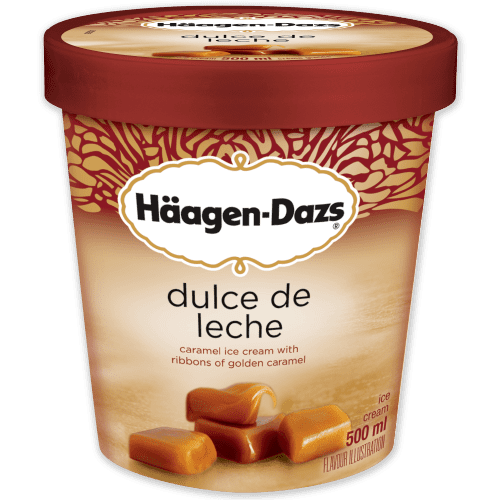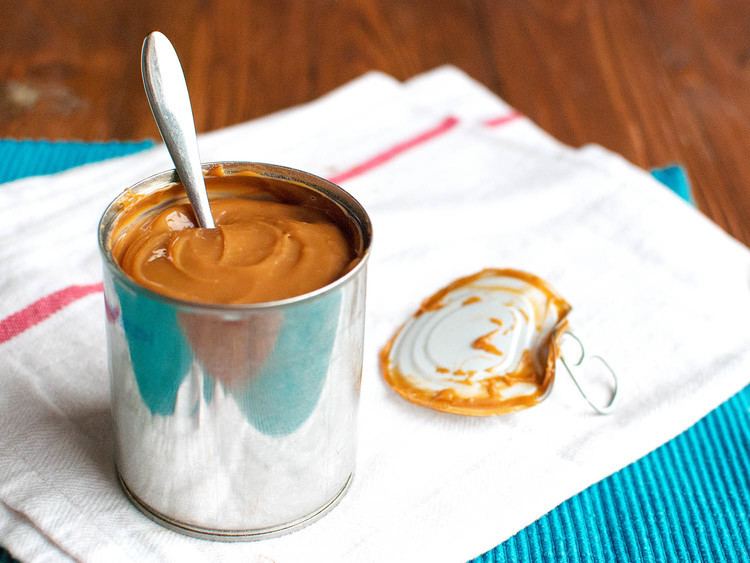Variations Cajeta, arequipe | Food energy(per serving) 320 kcal (1340 kJ) | |
 | ||
Alternative names Manjar, manjar blanco, arequipe Similar | ||
How to make dulce de leche gemma s bold baking basics ep 18
Dulce de leche ([ˈdulθe ðe ˈletʃe] in Spain; [ˈdulse ðe ˈletʃe] in Latin America; Portuguese: doce de leite [ˈdosi dʒi ˈlejtʃi] in Brazil or [ˈdosɨ dɨ ˈlejtɨ] in Portugal) is a confection prepared by slowly heating sweetened milk to create a substance that derives its taste from the Maillard reaction, changing flavour and colour. Literally translated, it means "candy [made] of milk" or "sweet [made] of milk." Its origin is a highly debated topic and it is popular in most Latin American countries.
Contents
- How to make dulce de leche gemma s bold baking basics ep 18
- Regional variants
- Preparation and uses
- References
Regional variants

The dulce de leche of El Salvador has a soft, crumbly texture, with an almost crystallized form. Central Mexico had versions as manjar (vanilla flavored) or cajeta, which is made from goat's milk, in the North of the country the "dulce de leche" from cow's milk is more common. In Cuba, dulce de leche is made from soured milk that's curdled and then sweetened, called cortada. In the Dominican Republic, it is made with equal parts milk and sugar with cinnamon, and the texture is more like fudge. In Puerto Rico, dulce de leche is sometimes made with unsweetened coconut milk. A variant of Chilean manjar incorporating cannabis-infused butter and originating in Valparaíso is called ganjar.
In Panama, the top is crystallized.

Dulce de leche is also popular in the Philippines, where it is usually paired with cakes or breakfast rolls. As in other places, it has also found its way into other desserts such as cakes and ice cream.

A French version, known as confiture de lait (literally "milk jam"), is very similar to the spreadable forms of dulce de leche. In Haiti, it is known as "douce lait".

The Norwegian HaPå spread is a commercial variant that is thicker and less sweet. The name is an abbreviation of "Hamar" where it originally was made and "Pålegg" (spread). "Ha på" literally means "put on" as a reference to putting it on a slice of bread. HaPå originated during the Second World War when, due to the scarcity of supplies, housewives would boil Viking-melk (a type of condensed milk) to a very similar type of spread. After the war the production was commercialized and continues to this day.

In Russia, the same preparation, traditionally made by boiling cans of condensed milk in water bath for several hours is known as "варёная сгущёнка" varyonaya sgushchyonka ("boiled condensed milk") as long as condensed milk is known there, and was (and still is) a mainstay of home confectioners and sweet fillings. In Soviet times there was some commercial production, but at a scale insufficient to meet a demand, so most households returned to traditional at-home preparation. Since the fall of the USSR the spread (though often imitated by various starch-based concoctions) exploded in popularity and is widely commercially produced both in can form and as an ingredient and default filling in various sweets.
A Polish version, called kajmak, is known from XVIII century (it was inspired by kaymak) and it is used to cover some cakes, like mazurek or wafer.
Preparation and uses
The most basic recipe calls for slowly simmering milk and sugar, stirring almost constantly, although other ingredients such as vanilla may be added for flavour. Much of the water in the milk evaporates and the mix thickens; the resulting dulce de leche is usually about a sixth of the volume of the milk used. The transformation that occurs in preparation is caused by a combination of two common browning reactions called caramelization and the Maillard reaction.
A home-made form of dulce de leche is sometimes made by boiling an unopened can of sweetened condensed milk for two to three hours (or 30 to 45 minutes in a pressure cooker), particularly by those living in countries where it cannot be bought ready-made. This results in a product that is much sweeter than the slow-boiled kind. It is dangerous to do this on a stove: if the pot is allowed to boil dry, the can will overheat and explode.
Dulce de leche is used to flavour candies or other sweet foods, such as cakes, churros, cookies (see alfajor), waffles, crème caramel (known as flan in Spanish and Portuguese-speaking regions), and ice creams; it provides the "toffee" part of English Banoffee pie and is also a popular spread on pancakes and toast, while the French confiture de lait is commonly served with fromage blanc.
A solid candy made from dulce de leche, similar to the Polish krówka and named Vaquita ("little cow"), was manufactured by the Mu-Mu factory in Argentina until the company went out of business in 1984. Subsequently, other brands began to manufacture similar candies, giving them names such as "Vauquita" and "Vaquerita" in an effort to link their products to the original.
